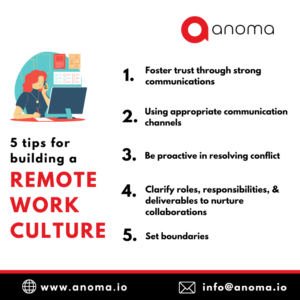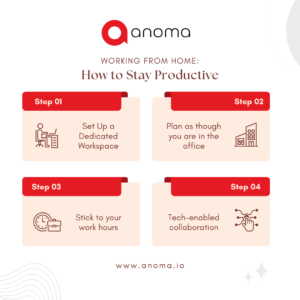- April 28, 2022
- Posted by: Author Anoma
- Categories:

“ The future of work consists of learning a living ’’ — Marshall McLuhan
A movement was brewing within knowledge-work organizations prior to 2020. “Do we really need to be together, in an office, to do our work?” people began to wonder.” Personal technology and digital connectivity have come a long way in such a short period of time. During the pandemic lockdowns, we got our answer.
We discovered that many of us do not need to be co-located with colleagues on-site to do our jobs. Individuals, teams, and entire workforces can and have performed well while being completely distributed. As a result, we are now faced with new questions: Is the future of knowledge work all-remote or mostly remote organizations? Is Work from Anywhere – Anoma Tech (WFA) a trend that will last?
Without a doubt, the model provides significant benefits to businesses and their employees. Organizations can reduce or eliminate real estate costs, hire and use talent globally while mitigating immigration issues, and possibly enjoy productivity gains, according to research.
If your company is considering a Work from Anywhere – Anoma Tech program, transition, or launch, this article can help.

A brief overview of remote work
The adoption of work-from-home (WFH) policies in the 1970s, as soaring gasoline prices caused by the 1973 OPEC oil embargo made commuting more expensive, arguably began a large-scale transition from traditional, colocated work to remote work.
These policies allowed people to Work from Anywhere – Anoma Tech, coworking spaces, or other community locations such as coffee shops and public libraries on occasion, on a regular part-time basis, or full-time, with the expectation that they would return to the office on a regular basis.
Workers were frequently given control over their schedules, allowing them to fit in school pickups, daily tasks, or midday exercise without being perceived as avoiding.
“ Aim high, work hard, and love your family ’’— Deborah Roberts
Millennials were enthralled by the prospect of traveling the world while still working
According to research, there are performance benefits. According to a 2015 study by Nicholas Bloom and co-authors, when employees opted into Work from Anywhere – Anoma Tech policies, their productivity increased by 13%. When the same workers were given the option of staying at home or returning to the office nine months later, those who chose the former saw even greater gains: they were 22 percent more productive than before the experiment.
This implies that people should probably decide for themselves which situation (home or office) is best for them.
TCS, for example, which employs nearly 418,000 people who were previously located on campuses or at client sites around the world, has decided to implement a 25/25 model: employees will spend only 25 percent of their working hours in the office, and the company will never have more than 25 percent of workers colocated. TCS anticipates completing this transition in five years.
Explore the advantages of working from home
For individuals,
One remarkable conclusion is how much these arrangements benefit workers. Many people told me that having the ability to live anywhere on the globe is a significant benefit. It alleviates the hardship of hunting for two jobs in one location for those in dual-career scenarios. “I’m a military spouse,” one patent examiner explained, “which means I live in a world where frequent movements and emotional upheavals prevent many spouses from pursuing long-term employment of their choice.”
“ Work is no longer a place ’’ — QDesk
WFA has been the most beneficial telework program I’ve come across. It permits me to follow my husband to any state in the United States at any time and pursue my own goals of contributing to my family and society.”
 For organizations,
For organizations,
WFA programs also provide numerous organizational benefits, according to my research. For example, they boost employee engagement, which is a key metric of a company’s success. The USPTO was voted first in the Best Places to Work in the Federal Government study in 2013, a year after it implemented work from anywhere.
Not only are employees happier, but they are also more productive. When Cirrus Foroughi, Barbara Larson, and I looked into the USPTO’s shift from WFH to WFA, we discovered that WFA increased individual productivity by 4.4 percent, as measured by the number of patients examined each month. Examiners also put in more effort as a result of the changeover.
Work from Anywhere – Anoma Tech
Of course, some organizations, such as manufacturing firms, may not be able to implement WFA at present time — though this may change as 3D printing, automation, digital twins, and other technologies improve. Many more firms, teams, and functions than one might think might become fully or mostly remote with the correct strategy, organizational processes, technologies, and — most importantly — leadership.
According to current research by Jan Bena and David Rowat, start-up knowledge-work organizations, particularly in the IT industry, are well-positioned to adopt a WFA model from the beginning.
Finally, remote employees have a better work-life balance and, as a result, are happier employees. Employees that are happier are more motivated, get sick less frequently, and like their jobs more. As a result, they’re more productive.
For more blog updates, Click here
